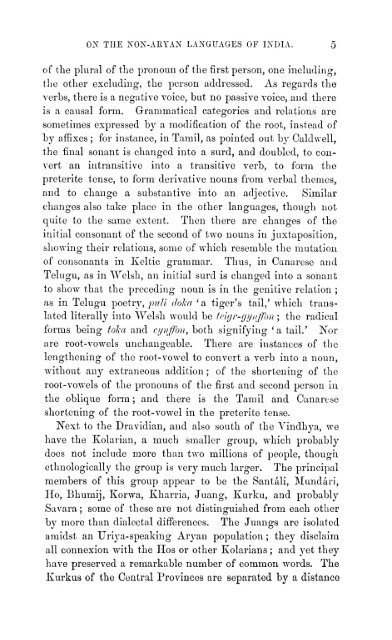You also want an ePaper? Increase the reach of your titles
YUMPU automatically turns print PDFs into web optimized ePapers that Google loves.
ON THE NON-AETAN LANGUAGES OF INDIA. 5<br />
<strong>of</strong> <strong>the</strong> plural <strong>of</strong> <strong>the</strong> pronoun <strong>of</strong> <strong>the</strong> first person, one including,<br />
<strong>the</strong> o<strong>the</strong>r excluding, <strong>the</strong> person addressed. As regards <strong>the</strong><br />
verbs, <strong>the</strong>re is a negative voice, but no passive voice, and <strong>the</strong>re<br />
is a causal form. Grammatical categories and relations are<br />
sometimes expressed by a modification <strong>of</strong> <strong>the</strong> root, instead <strong>of</strong><br />
by affixes ; for instance, in Tamil, as pointed out by Caldwell,<br />
<strong>the</strong> final sonant is changed into a surd, and doubled, to con-<br />
vert an intransitive into a transitive verb, to form <strong>the</strong><br />
preterite tense, to form derivative nouns from verbal <strong>the</strong>mes,<br />
and to change a substantive into an adjective. Similar<br />
changes also take place in <strong>the</strong> o<strong>the</strong>r <strong>languages</strong>, though not<br />
quite to <strong>the</strong> same extent. Then <strong>the</strong>re are changes <strong>of</strong> <strong>the</strong><br />
initial consonant <strong>of</strong> <strong>the</strong> second <strong>of</strong> two nouns in juxtaposition,<br />
showing <strong>the</strong>ir relations, some <strong>of</strong> which resemble <strong>the</strong> mutation<br />
<strong>of</strong> consonants in Keltic grammar. Thus, in Canarese and<br />
Telugu, as in Welsh, an initial surd is changed into a sonant<br />
to show that <strong>the</strong> preceding noun is in <strong>the</strong> genitive relation ;<br />
as in Telugu -poetry, pnll doka 'a tiger's tail,' which trans-<br />
lated literally into Welsh would be feigr-gi/njfon ; <strong>the</strong> radical<br />
forms being toJia and cyvffon, both signifying 'a tail.' Nor<br />
are root-vowels unchangeable. There are instances <strong>of</strong> <strong>the</strong><br />
leng<strong>the</strong>ning <strong>of</strong> <strong>the</strong> root- vowel to convert a verb into a noun,<br />
without any extraneous addition ; <strong>of</strong> <strong>the</strong> shortening <strong>of</strong> <strong>the</strong><br />
root-vowels <strong>of</strong> <strong>the</strong> pronouns <strong>of</strong> <strong>the</strong> first and second person in<br />
<strong>the</strong> oblique form ; and <strong>the</strong>re is <strong>the</strong> Tamil and Canarese<br />
shortening <strong>of</strong> <strong>the</strong> root-vowel in <strong>the</strong> preterite tense.<br />
Next to <strong>the</strong> Dravidian, and also south <strong>of</strong> <strong>the</strong> Vindhya, we<br />
have <strong>the</strong> Kolarian, a much smaller group, which probably<br />
does not include more than two millions <strong>of</strong> people, though<br />
ethnologically <strong>the</strong> group is very much larger. The principal<br />
members <strong>of</strong> this group appear to be <strong>the</strong> Santali, Mundari,<br />
Ho, Bhumij, Korwa, Kharria, Juang, Kurku, and probably<br />
Savara ; some <strong>of</strong> <strong>the</strong>se are not distinguished from each o<strong>the</strong>r<br />
by more than dialectal differences. The Juangs are isolated<br />
amidst an Uriya-speaking <strong>Aryan</strong> population ; <strong>the</strong>y disclaim<br />
all connexion with <strong>the</strong> Hos or o<strong>the</strong>r Kolarians ; and yet <strong>the</strong>y<br />
have preserved a remarkable number <strong>of</strong> common words. The<br />
Kurkus <strong>of</strong> <strong>the</strong> Central Provinces are separated by a distance

















